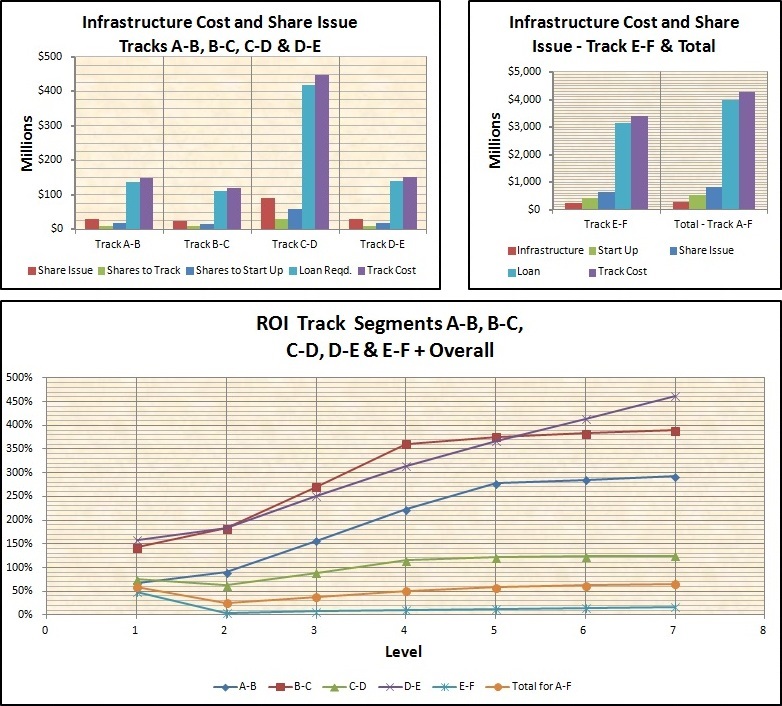
|
Galilee Basin Coal Mines to Karumba in the Gulf of Carpentaria:-This analysis is the same as for the Galilee Basin Mines - Bowen proposal except that the last section of track is diverted to Karumba instead of going to Bowen. This is a proposed system to transport coal from the Galilee Basin Coal mines to a new coal loading facility at Karumba in the Gulf of Carpentaria. There are five mines included in this proposal - China Stone, Carmichael Coal, Kevin’s Corner, Alpha Coal and China First. Coal transport charges vary between $13.52/tonne (China Stone) and $16.80/tonne (China First). The unit cost is $0.0170/Ntk (nett tonne kilometre). There may well be some Government subsidies available (refer below).
The CoalTran coal transport vehicle has a 50 tonne capacity and travels at 200 km/h. It has pneumatic tyres that run on an elevated steel rail, as shown in the graphics attached, and can traverse grades that a normal truck can. Hence, it is feasible that CoalTrans could deliver the coal directly to the loader conveyor at the port. This would obviate stockpiling at the port and the consequent double handling of the product. Delivery of 8,000 tonnes/hour would require the arrival of 160 CoalTrans/hour at the port. The number of CoalTrans required to achieve this is dependent on the distance of each mine from the port. As well as servicing the coal transport needs of the mines, this system has capacity for additional traffic for freight (e.g. mine equipment/supplies) or passengers (e.g. F.I.F.O. staff). Nominal figures have been included for these in the study. With the addition of extra mini-stations etc. along the route, the system could also service local communities/land owners. As the track is elevated a minimum of five metres above ground on columns at 30 - 35 metre centres, it has no impact on ground level vehicular traffic, pedestrians, animals, livestock or hydrology. A big plus when it comes to negotiating with land owners along the route for permission to cross their land. The track route is very flexible due to the grades that can be negotiated as a result of the pneumatic tyres etc. as mentioned above. The longitudinal profile of the track can also be varied simply by variation of the column heights or the incorporation of simple bridges across gullies. It is conceivable that, in some instances, the column height could be 15 metres or more. The determining factor for the track route will often be the grades required for the access road needed for the track construction and maintenance. Being elevated, the system is virtually immune to service interruptions due to weather. The track will always be built safely above flood levels. Only cyclones may impact on its operations and any impact will be of short duration. The rails of the track are very substantial (1200WB 314) and, hence, will be extremely resistant to damage. Common sense dictates that the track operations would be suspended during a cyclonic event and, subsequently, while the track is checked for any resultant damage or debris (e.g. fallen trees or branches across the track). An additional benefit of this proposal is that the track is able to carry pipes/conduits for water, oil, gas, electricity, communications (e.g. NBN), etc. if required. The sails under the track are an optional extra only for rainwater harvesting, hence their costs have not been included in the coal transport costs. There have been many concerns raised about the effect the mines’ water supply requirements will have on other parties external to the mines and ground water, hence their details have been included as a possible alternate additional water source. The water harvesting figures are on the basis of sails to 100% of the track between the China First and China Stone mines. An allowance of 1% of the track downstream of the China Stone mine has been included. This is intended to be used, as desired, as part of any reparation to landowners for the track crossing their land. Any water harvested and stored by them would be a valuable adjunct to a land owner’s operations during drought. Also, the CoalTran vehicles could be used to transport water from the coast to the mine on their return journey (32,000 L/trip). Karumba Pros & Cons:-Cons
Pros
FinancesThe financial study is based on the formation of a new public company (listed or unlisted) that would raise start up capital from a share issue. Part of these funds would be used for the design and initial operating phase and the remainder directed to the track construction. The vehicles would be purchased, as required, using separate loan funding. The vehicle repayments have been included in this study.
The figures include a generous administration surcharge on the operating costs (excluding interest and redemption charges on the track loans). This study does not include the cost of the coal loading infrastructure at the mine sites or the port. Other Case Studies Galilee Basin coal mines to Bowen
|
|
During public displays of our MonoCab VRT model, we conduct a written survey (name, address and comments). We
also ask respondents two questions:- The Response:- |

